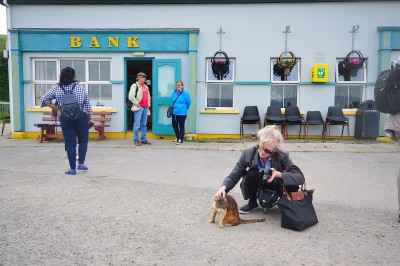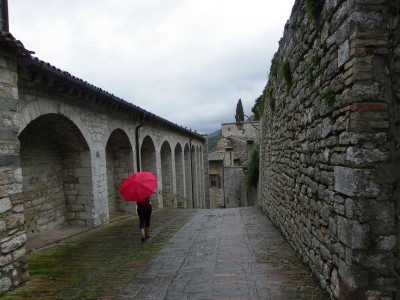‘Tis true, what it says in Ecclesiastes. Fittingly then, I am going to re-post here a couple of articles I wrote a few years back, both related to current events: in honour of the World Cup, I give you my essay about attending a Serie A match in Italy in 2013 (though ’twas published in 2014); and not in honour but given that the Calgary Stampede has just started up, I give you this piece from three years back.
Tag Archives: moi
Ireland
Dear readers, I am back from a wonderful trip to Ireland, about which I will be writing here (and in other places) anon. I wanted to start with a picture of myself taken on Whiddy Island, Ireland. I rarely post — and even more rarely appreciate — pictures of myself. But I truly like this photo, because I think it sums me up in a frame (a woman with bad hair who, when in the presence of a kitty, is oblivious to all else). I will write more about this photo later, and in particular this cat, but for now I would just like to thank my colleague Hermann Low for taking and sending it. Danke.

My Latest
My Latest…
My Latest Column
It’s here at the Wall Street Journal (apologies if there’s a paywall).
My Latest…
…in the Montreal magazine Accenti, about my time in Italy last year during the earthquakes.
Travel
A(nother) great Nick Cohen Column
The column in question is ostensibly about why we should all become Jews. Of course, Cohen isn’t really suggesting we should, although Significant Other and I often say that we will have to join the Israel Army one of these days…if they would have two middle-aged out of shape folks.
It’s a column about the pathology of anti-Semitism and how far it is spreading, in particular its grip on much of the political left.
But consider how many leftwing activists, institutions or academics would agree with a politer version [of blatant anti-Semitism].
Western governments are the main source of the ills of the world. The “Israel lobby” controls western foreign policy. Israel itself is the “root cause” of all the terrors of the Middle East, from the Iraq war to Islamic State. Polite racism turns the Jews, once again, into demons with the supernatural power to manipulate and destroy nations. Or as the Swedish foreign minister, Margot Wallström, who sees herself as a feminist rather than a racial conspiracist, explained recently, Islamist attacks in Paris were the fault of Israeli occupiers in the West Bank.
(Oh man, I know so many people — some to whom I am related — who buy such nonsense. Depressing. As my late brother used to say, “the ’60s have a lot for which to answer.”)
Cohen writes of his own experiences (his father was Jewish, not his mother) growing up with a Jewish name and in particular of the temptation — which he resisted — to become a self-loathing Jew.
He does suggest one pretend to be Jewish to see how people’s reactions to you change. It’s fascinating, because when I was in Italy in 2014, there was this awful woman who was always very mean to me and I remember one day she asked me if I was Jewish. I just knew that if I answered “yes,” she would have hated me even more, but I thought the fact that she suspected it (as though it were a crime) was revealing.
The Cow Who…
Meant to post this a while back, but stuff (travels, colds, work) got in the way. A few weeks ago, Peter Singer wrote about the New York Times’ use of the word “who” in regards a cow, rather than “that” or “which.” To me, it doesn’t seem odd to use “who” regarding an animal, as animals are not only sentient beings, but individuals. Nor is it odd to Singer, though he points out that the Times‘ decision was not the great step forward some of us might like to see.
It would be premature to conclude that the New York Times article indicates a shift in usage. Rather, it seems to show uncertainty, for the first line of the article refers to “A cow that was captured by police.”
I asked Philip Corbett, the standards editor for the New York Times, if the use of “cow who” reflected a change of policy. He told me that the Times style manual, like that of the Associated Press, suggested using “who” only for a named or personified animal. The manual gives the example “The dog, which was lost, howled” and contrasts this with “Adelaide, who was lost, howled.”
I find this noteworthy, not just because I am an animal rights advocate, but because I had a conflict — not a big one — with an editor years ago when I wrote about a whale for the Christian Science Monitor. I referred to the whale as “he,” first of all, and I also referred to the whale’s uncle. Both of these things bothered the editor with whom I was dealing, although she heard me out and graciously printed the article the way I had wanted (for the most part). Newspapers have their style guidelines, and they have to be heeded to a point. They can change, though, as views change.
In a language like English, which implicitly categorizes animals as things rather than persons, adopting the personal pronoun would embody the same recognition – and remind us who animals really are.
Honourable Mention
One of my favourite places in Italy is Gubbio, a small city near Assisi and Perugia. (St. Francis tamed a wolf there and said wolf is buried in a church there. Seriously.) It has a rickety old funicular thingy that will take you right up to its very top, on the tippity-top of a mountain, but it is also fun to simply walk up (as far as you can) and back down the city. I did that one day in December with a Vietnamese friend/classmate and I shot this picture quite haphazardly. My friend had walked ahead of me as I tied my shoelace, and when I looked up I snapped the shot. My main goal was to get a picture of the architecture but it came out better like this. All of this is to say that this photo won honourable mention in Accenti Magazine’s 2015 photography awards (Accent is an arty magazine out of Montreal). I would have preferred winning but I think I’m kind of like one of those TV characters — on the Waltons or Eight is Enough — who never wins anything, always just comes second and yet learns valuable lessons along the way. Ahem.

